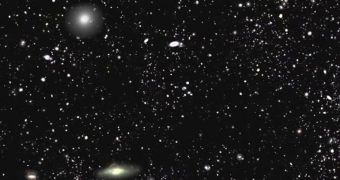Experts in charge of the Sloan Digital Sky Survey III (SDSS-III) last week released the largest, most comprehensive map of a large sector of the Universe ever compiled. The 3D dataset covers the equivalent of a cube with a width of 4 billion light-years.
The most important elements in the new map are massive galaxies and very distant black holes. The purpose of the effort was to provide a starting point for future studies, which will add new data to the existing catalog.
In all, more than 1 million galaxies have been accurately mapped, their locations and distances from Earth precisely measured and cataloged. SDSS-III researchers say that they want to map the largest volume in the Universe possible with current technologies.
We want “to use that map to understand how the expansion of the Universe is accelerating,” explains the director of the SDS-III initiative, Daniel Eisenstein. The expert is based at the Harvard-Smithsonian Center for Astrophysics (CfA).
The study is actually a six-year survey project, with the new map representing the results of two years of investigations. The dataset contains images of more than 200 million galaxies, and spectral readings of about 1.35 million galaxies. The map was part of Data Release 9.
“Our goal is to create a catalog that will be used long after we are done,” says New York University expert Michael Blanton, the leader of the team that prepared the release. Data from the SDSS-III Baryon Oscillation Spectroscopic Survey (BOSS) is also included in the 3D map.
The purpose of BOSS is to measure distances between us and massive galaxies located up to 6 billion light-years away. In addition, it will also keep track of giant, active black holes (called quasars), up to 12 billion light-years away from Earth.
Data collected by BOSS and SDSS-III will enable astrophysicists to gain a better understanding of just how much dark matter and dark energy are available in the Universe. Thus far, efforts to study the two directly have failed.
“Dark matter and dark energy are two of the greatest mysteries of our time. We hope that our new map of the Universe can help someone solve the mystery,” says the principal investigator of BOSS, Lawrence Berkeley National Laboratory (Berkeley Lab) expert David Schlegel.

 14 DAY TRIAL //
14 DAY TRIAL //